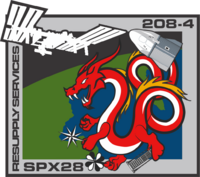Engineering:SpaceX CRS-28
 CRS-28 detached from upper stage | |
| Names | SpX-28 |
|---|---|
| Mission type | ISS resupply |
| Operator | SpaceX |
| Mission duration | 24 days, 22 hours and 43 minutes |
| Spacecraft properties | |
| Spacecraft | Cargo Dragon |
| Spacecraft type | Cargo Dragon |
| Manufacturer | SpaceX |
| Dry mass | 9,525 kg (20,999 lb) |
| Dimensions | Height: 8.1 m (27 ft) Diameter: 4 m (13 ft) |
| Start of mission | |
| Launch date | 5 June 2023, 15:47 UTC[1][2] |
| Rocket | Falcon 9, B1077.5 |
| Launch site | Kennedy Space Center, LC-39A |
| Contractor | SpaceX |
| End of mission | |
| Recovered by | Shannon (ship) |
| Landing date | 30 June 2023, 14:30 UTC |
| Landing site | Atlantic Ocean |
| Orbital parameters | |
| Reference system | Geocentric orbit |
| Regime | Low Earth orbit |
| Inclination | 51.66° |
| Docking with ISS | |
| Docking port | Harmony zenith |
| Docking date | 6 June 2023, 09:54 UTC |
| Undocking date | 29 June 2023, 16:30 UTC |
| Time docked | 23 days, 6 hours and 36 minutes |
 SpaceX CRS-28 mission patch | |
SpaceX CRS-28, also known as SpX-28, is a Commercial Resupply Service mission to the International Space Station (ISS) launched on 5 June 2023.[1] The mission was contracted by NASA and flown by SpaceX using Cargo Dragon C208. It was the eighth flight for SpaceX under NASA's CRS Phase 2.[3]
Cargo Dragon
SpaceX plans to reuse the Cargo Dragons up to five times. The Cargo Dragon will launch without SuperDraco abort engines, without seats, cockpit controls and the life support system required to sustain astronauts in space.[4][5] Dragon 2 improves on Dragon 1 in several ways, including lessened refurbishment time, leading to shorter periods between flights.[6]
The new Cargo Dragon capsules under the NASA CRS Phase 2 contract will land east of Florida in the Atlantic Ocean.[4][7]
Payload
NASA contracted for the CRS-28 mission from SpaceX and therefore determines the primary payload, date of launch, and orbital parameters for the Cargo Dragon.[8][9]
- Science investigations: 266 kg (586 lb)
- Vehicle hardware: 491 kg (1,082 lb)
- Crew supplies: 1,098 kg (2,421 lb)
- Spacewalk equipment: 48 kg (106 lb)
- Computer resources: 4 kg (8.8 lb)
ISS Roll Out Solar Arrays (iROSA) Third pair of new solar arrays using XTJ Prime space solar cells. They were delivered to the station in the unpressurized trunk of the SpaceX Cargo Dragon spacecraft.[10]
The installation of these new solar arrays will require two spacewalks each: one to prepare the worksite with a modification kit and another to install the new panel.[11][12]
Research
NASA Glenn Research Center studies:[13]
CubeSats
CubeSats planned for this mission:
SC-ODIN is a student-led Earth observation mission developed at Concordia University and supported by the Canadian Space Agency (CSA) as part of the Canadian CubeSat Project (CCP) initiative. The mission's primary objective is to help improve our understanding of airborne particles in the atmosphere. This is significant for developing climate-aerosol models that are valuable in the context of advancing climate science. The 3U CubeSat uses a high performing CMOS sensor (GomSpace NanoCam) as its primary payload to take color images of Lake Colhué Huapí in Argentina and the coastal regions of Namibia. Using image processing techniques, researchers can extract aerosol optical depth (AOD) measurements to study the role and impact of dust storms on Earth's climate system. This research is co-led with Université de Montréal. A secondary payload consists of RADFET radiation sensors to monitor the total ionizing dose (TID) that the spacecraft is exposed to. The collected data will improve humanity's understanding of the effects of radiation on various components and hardware by characterizing the radiation environment in low Earth orbit (LEO).[14]
Moonlighter This 3U CubeSat was designed by Aerospace Corporation as a cyber test platform and developed in partnership with Space Systems Command (SSC) and the Air Force Research Laboratory (AFRL). Its purpose is to advance space cybersecurity by providing the national security space community with the ability to test and learn in real-time in orbit. Once deployed in summer 2023, Moonlighter’s first mission is to host challenges for the Hack-A-Sat 4 Final Event, which is the first Capture the Flag hacking competition with on-orbit challenges taking place at DEF CON 31 in the Aerospace Village.[14]
RADSAT-SK is a joint project between the USST, The University of Saskatchewan, Saskatchewan Polytechnic, and the Canadian Space Agency and has three technical objectives. The first of which is the validation and testing of a new type of radiation dosimeter being developed by faculty at the College of Engineering. This new type of sensor is much smaller and cheaper than current space-grade dosimeters. Along with the dosimeter the project scientists will also be testing the use of high-concentration melanin as a radiation shield in space. This research is also being conducted at the U of S by faculty at the college of pharmacology. Lastly, RADSAT-SK will have an earth-imaging camera onboard in the hope that the science team can capture some images of Saskatchewan from space that they can share with the province.[15]
The Educational Space Science and ENgineering CubeSat Experiment Mission (Nanoracks-ESSENCE) includes scientific and technical research activities. The scientific tasks focus on Earth observation of arctic ice, permafrost thaw and forest coverage in Northern Canada, and the measurement of solar energetic protons. The payloads are a fisheye camera and a proton detector. They are designed to help fight climate change by improving our understanding of solar proton events to better design and protect spacecraft for a successful mission. The technical task is to examine the effectiveness and robustness of novel attitude navigation and control theory and algorithms using reaction wheels and magnetorquers. Specifically, the task is to demonstrate the attitude control of spacecraft using two reaction wheels with our algorithms by assuming the third one has failed. In case of attitude actuator failure in a fully actuated spacecraft, such control measures provide a means to recover the mission, although with possible degraded performance.
Launch and docking
The CRS-28 resupply mission was originally planned to launch on 4 June 2023, at 16:12:41 UTC. However, the countdown was stopped at T-01:49:08, and SpaceX scrubbed the mission and postponed it to the day after due to high winds in the recovery area. SpaceX announced, about 45 minutes afterward, the new T-0, planned for 15:47 UTC. The Falcon 9 rocket and the Cargo Dragon spacecraft lifted off at the new T-0, from the Kennedy Space Center's Space Launch Complex-39A. The first stage separation happened at T+02:38 and the Falcon 9 landed at T+09:05 on the A Shortfall of Gravitas droneship. At T+12:11, the Cargo Dragon separated from the second stage.
Dragon docked to the International Space Station's Harmony module on Tuesday, June 6, at 09:54 UTC.[16]
On June 7, SpaceX announced on Twitter that on the previous day the Dragon 2 fleet as a whole had accumulated 1,324 days in orbit, surpassing the Space Shuttle program's total time in space. SpaceX also said that the mission was the 38th mission to ISS for Dragon 1 and 2 capsules, which exceeded the Shuttle's 37 ISS missions.[17]
See also
References
- ↑ 1.0 1.1 Baylor, Michael. "Falcon 9 Block 5 - SpX CRS-28". Next Spaceflight. https://nextspaceflight.com/launches/details/5345.
- ↑ "SpaceX". https://www.spacex.com/launches/mission/?missionId=crs-28.
- ↑ Reckart, Timothy (2022-06-15). "Microgravity Research Flights". https://www1.grc.nasa.gov/space/iss-research/microgravity-research-flights/.
- ↑ 4.0 4.1 Office of Inspector General (26 April 2018). Audit of Commercial Resupply Services to the International Space Center (Report). IG-18-016. NASA. pp. 24, 28–30. https://oig.nasa.gov/docs/IG-18-016.pdf. Retrieved 4 April 2021.
 This article incorporates text from this source, which is in the public domain.
This article incorporates text from this source, which is in the public domain.
- ↑ "Dragon 2 modifications to Carry Cargo for CRS-2 missions". Teslarati. https://www.teslarati.com/spacex-no-crew-dragon-spaceship-reuse-nasa-astronaut-launches/cargo-dragon-2-required-modifications/.
- ↑ Clark, Stephen (2 August 2019). "SpaceX to begin flights under new cargo resupply contract next year". Spaceflight Now. https://spaceflightnow.com/2019/08/02/spacex-to-begin-flights-under-new-cargo-resupply-contract-next-year/.
- ↑ Clark, Stephen (2 August 2019). "SpaceX to begin flights under new cargo resupply contract next year". Spaceflight Now. https://spaceflightnow.com/2019/08/02/spacex-to-begin-flights-under-new-cargo-resupply-contract-next-year/.
- ↑ "SpaceX Commercial Resupply". ISS Program Office. NASA. 1 July 2019. https://www.nasa.gov/mission_pages/station/structure/launch/spacex.html.
 This article incorporates text from this source, which is in the public domain.
This article incorporates text from this source, which is in the public domain.
- ↑ "NASA's SpaceX CRS-28 Mission Overview". https://www.nasa.gov/content/nasas-spacex-crs-28-mission-overview. Retrieved 2023-09-04.
- ↑ "Current and Future Operations and Challenges with International Space Station" (PDF). ISS Program Office. NASA. 15 October 2020. https://www.nationalacademies.org/documents/embed/link/LF2255DA3DD1C41C0A42D3BEF0989ACAECE3053A6A9B/file/D0CE42612418D93FC850A8B8383F306148EC43CCAE2D.
- ↑ Clark, Stephen (13 January 2021). "Boeing says assembly complete on first set of new space station solar arrays". Spaceflight Now. https://spaceflightnow.com/2021/01/13/boeing-says-assembly-complete-on-first-set-of-new-space-station-solar-arrays/.
- ↑ "SpaceX launches Dragon cargo ship to deliver new solar arrays to space station – Spaceflight Now". https://spaceflightnow.com/2022/11/26/spacex-launches-dragon-cargo-ship-to-deliver-new-solar-arrays-to-space-station/.
- ↑ "ISS Research Program". Glenn Research Center. NASA. 1 January 2020. https://www1.grc.nasa.gov/space/iss-research/.
 This article incorporates text from this source, which is in the public domain.
This article incorporates text from this source, which is in the public domain.
- ↑ 14.0 14.1 Josh Dinner (June 2, 2023). "World's 1st 'hacking sandbox' satellite and more to ride on SpaceX's next NASA cargo launch". space.com. https://www.space.com/spacex-cargo-crs-28-international-space-station-science.
- ↑ Layne Ransom (May 29, 2023). "USask student satellite to be launched to the International Space Station". University of Saskatchwewan. https://news.usask.ca/articles/research/2023/usask-student-satellite-to-be-launched-to-the-international-space-station.php.
- ↑ Mike Wall (June 6, 2023). "SpaceX Dragon CRS-28 cargo capsule docks with space station to deliver vital supplies". space.com. https://www.space.com/spacex-dragon-crs-28-cargo-mission-docking.
- ↑ Wall, Mike (2023-06-09). "SpaceX Dragon breaks 2 space shuttle orbital records" (in en). https://www.space.com/spacex-dragon-breaks-space-shuttle-records.
 |



